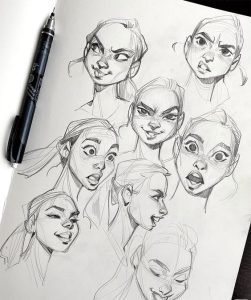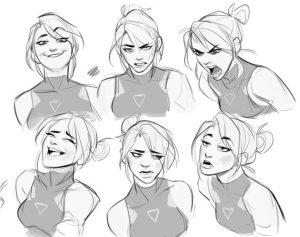Artistic Expressions
Of course! Artistic expressions encompass a wide range of creative forms, from visual arts to literature, music, dance, and more. Read about Refining Your Elegance
Here are some ways people express themselves artistically in English:
Visual Arts:
- Painting: Artists use various mediums like oil, acrylics, watercolors, and more to create visually captivating images.
- Sculpture: Sculptors manipulate materials like clay, wood, metal, or stone to craft three-dimensional art pieces.
- Drawing: Pencil, charcoal, ink, and digital tools are used to create detailed and expressive drawings.

Literature:
- Poetry: Poets use words and rhythm to convey emotions, thoughts, and stories through verse.
- Prose: Authors write novels, short stories, and essays to explore themes, characters, and narratives.
- Playwriting: Playwrights craft scripts for theatre productions, combining dialogue and stage directions.
Music:
- Composition: Musicians create original music through writing sheet music or digital compositions.
- Performance: Singers, instrumentalists, and bands perform live or record their music for others to hear.
Also read the Article: Fashion Figure Drawing
Dance:
- Choreography: Choreographers design dance routines that convey emotions, tell stories, or explore movements.
- Performance: Dancers execute choreographed routines to express themselves physically.
Film and Photography:
- Filmmaking: Directors, screenwriters, and cinematographers collaborate to create movies that tell stories or evoke emotions.
- Photography: Photographers use cameras to capture moments, scenes, and artistic compositions.
Fashion:
- Fashion Design: Designers create clothing and accessories as wearable art, expressing concepts and aesthetics.
- Modeling: Models showcase clothing and fashion designs through their physical expression.
Digital Art:
- Digital Painting: Artists use software and digital tools to create paintings and illustrations.
- Digital Animation: Animators bring characters and stories to life through digital animation techniques.
Performance Art:
- Theatre: Actors and actresses perform on stage to portray characters and convey narratives.
- Performance Art: Artists create unconventional, often provocative performances that challenge norms and provoke thought.
Crafts:
- Pottery: Potters shape clay into functional or decorative pottery items.
- Jewellery Making: Artisans craft unique jewelry pieces using various materials.
- Street Art and Graffiti: Street artists use public spaces as canvases to share their messages, often with political or social undertones.
The Essence of Artistic Expressions
Artistic expressions, in their myriad forms, are the means through which individuals communicate their innermost feelings, ideas, and perspectives to the world. These expressions encompass a wide range of mediums, including visual arts, music, literature, and performing arts. Let’s dive deeper into each of these categories to understand the diverse ways in which humans convey their thoughts and emotions.

Visual Arts: Painting the Canvas of Emotions
The world of visual arts is a canvas where artists paint their emotions, thoughts, and experiences. From classical masterpieces to contemporary creations, paintings and sculptures offer a window into the artist’s soul. Each stroke of the brush or chisel on the stone is a deliberate act of expression, creating an intricate tapestry of emotions and meanings.
The Power of Colors
Colors play a pivotal role in visual arts, with each hue carrying its own symbolism. Artists use colors to evoke emotions and convey messages. For example, warm colors like red and orange can symbolize passion and energy, while cool colors like blue and green may represent calmness and tranquillity.
Music: The Universal Language of Emotion
Music transcends language barriers and speaks directly to the heart. It is a powerful form of artistic expression that can convey a wide range of emotions, from joy and happiness to sorrow and longing. Whether through the soaring melodies of a symphony or the raw energy of rock and roll, music has the ability to stir our souls.
The Melody of Emotion
Musicians compose melodies that resonate with the human experience. Through the arrangement of notes, tempo, and dynamics, they craft songs that can uplift, soothe, or provoke deep reflection. Music connects us on a profound level, allowing us to share in the artist’s emotional journey.
Literature: Words That Paint Pictures
Literature, in the form of poetry, prose, and storytelling, has the power to transport readers to different worlds and evoke a myriad of emotions. Authors use words as their paintbrush, creating vivid imagery and narratives that can leave a lasting impact.
The Beauty of Metaphors
Metaphors and allegories are common literary devices used to infuse deeper meaning into written works. They allow readers to see beyond the surface and explore the layers of emotion and symbolism hidden within the text. Just as a painting tells a story through visuals, literature weaves tales through words.
Performing Arts: The Drama of Life
The world of performing arts, including theatre, dance, and cinema, brings stories to life through the physical and emotional expressions of actors and performers. It is a medium where the human body becomes the canvas for storytelling.
The Emotion in Movement
Dance, in particular, is a captivating form of expression where every movement is deliberate and laden with emotion. It can convey love, anger, joy, and sorrow without the need for words. The stage becomes a realm where emotions are laid bare for the audience to experience.
The Significance of Artistic Expressions
Artistic expressions hold immense significance in our lives and society as a whole. They provide a platform for individuals to connect, reflect, and understand the world around them. Art encourages dialogue and fosters a sense of empathy as we explore the diverse perspectives and experiences of others.
Conclusion
In conclusion, artistic expression is the vibrant tapestry of human creativity and emotion. Whether through visual arts, music, literature, or performing arts, they offer us a glimpse into the depths of the human soul. As we continue to celebrate and appreciate these forms of expression, let us remember that art has the power to unite, inspire, and transform our world.
FAQs
Q. What is the origin of artistic expression?
A. Artistic expressions have been a part of human culture since ancient times, with cave paintings dating back thousands of years.
Can anyone become an artist?
Yes, anyone can explore their artistic side and become an artist in their own unique way, regardless of formal training.
Q. How does art therapy benefit mental health?
A. Art therapy provides a creative outlet for individuals to express their emotions, leading to improved mental well-being.
Q. What is the role of art in social movements?
A. Art often serves as a powerful tool for conveying messages and raising awareness within social and political contexts.
Q. Are there any famous examples of artistic expression?
A. Yes, famous examples include Leonardo da Vinci’s “Mona Lisa,” Beethoven’s “Symphony No. 9,” Shakespeare’s “Romeo and Juliet,” and Michael Jackson’s “Thriller.”
